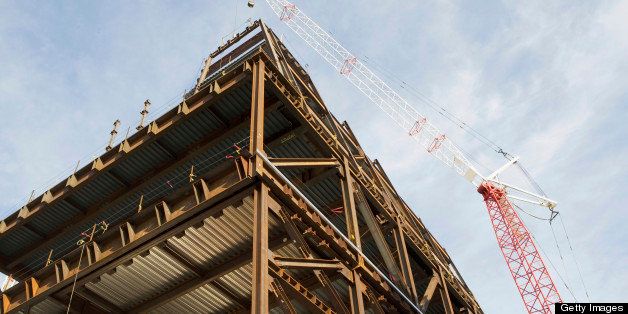
Much media and public attention is focused on the pending demise of the building that housed the American Folk Art Museum on West 53rd Street in Manhattan, which the Museum of Modern Art plans to tear down to make way for its own further expansion. It's ironic that the future of the 12-year-old building -- so stunningly designed by architects Tod Williams and Billie Tsien -- would depend on the very institution that the building was designed to stand up to in the first place. In a curious twist, the Museum of Modern Art's own reputation will be impacted by the relationship that it now chooses to establish with the building.
The brilliance of the design of the American Folk Art Museum building is evident both inside and out. The challenge for its exterior was to hold its own, despite its being only the width of two brownstones (40 feet in total), on a block dominated by the sprawling Museum of Modern Art. The architects' solution was a sculptural bronze façade that distinguishes itself from the steel and glass of MOMA while still conforming to the scale of the streetscape. That distinction now threatens the building. As the New York Times reports, "MoMA officials said the building's design did not fit their plans because the opaque facade is not in keeping with the glass aesthetic of the rest of the museum."
The challenge on the inside of the American Folk Art Museum building was to meet three simultaneous needs, despite the small dimensions: to produce a space that was compelling and not cramped; to provide sufficient exhibit space that displayed the art appealingly; to meet the functional requirements of a museum, including such amenities as elevators, an auditorium, a gift shop, and a café, as well as office space for the museum staff. The architects' solution was again brilliant, somehow managing to create a space that seemed to soar -- because of a dramatic, sky-lighted, grand stairway that narrowly extended several stories high -- while revealing a patchwork of exhibit spaces on different floors. The stairway had the effect of tying together the squares of exhibit space, much as the quilters, whose work was often highlighted, had done in assembling their own works of folk art.
The challenge that the Museum of Modern Art faces, if it proceeds with its plans, is how to square its own commitment to the stewardship of modern art with the destruction of this masterwork in order to expand further its facilities on its own terms. That quandary is compounded by the fact that the exterior of the American Folk Art Museum building conforms handsomely to the 53rd Street streetscape, even providing an example of modern art -- the sculptural façade -- which at MOMA is otherwise hidden behind steel and glass.
Despite its short existence, the future of the American Folk Art Museum building has for years been uncertain. The Museum struggled to be financially sustainable, ultimately having to sell the building to MOMA, which rescued the Museum financially, in part because of the appeal of the building's proximity. The idea that MOMA might tear down the Museum building was hardly a surprise.
Nevertheless, it poses a public and growing dilemma for MOMA and historic preservation more broadly. What value do we, as a community, place on recent architectural masterworks, and how should that value be reflected in the stewardship of a museum devoted to modern art?
With the American Folk Art Museum building now padlocked and its interior no longer open to the public, New Yorkers can fortunately still enjoy the breathtaking interior designs of Tod Williams and Billie Tsien by visiting the David Rubenstein Atrium at Lincoln Center, a spectacular public space on Broadway between 62nd and 63rd Streets, that our communications firm helped unveil several years ago. As they did for the American Folk Art Museum, the architects created a stunning space that meets a multitude of needs in a small area -- in this case, 9600 square feet in total. The David Rubenstein Atrium, open daily, provides a vibrant community gathering place, a venue for free performances, a place to buy discount tickets to available Lincoln Center performances, and a place to join a staffed tour of Lincoln Center.
All of those civic offerings and more are combined in a space that is at once dramatic and inspiring, contemporary and modern, welcoming and comfortable. It's a remarkable example of the brilliance of Tod Williams and Billie Tsien and underscores the importance of pausing and considering carefully any plans to destroy their work. Their designs make clear that compelling and functional space can be created, even when the space doesn't seem at first to be well-suited to the need.
The author is Chief Operating Officer of Goodman Media International.
